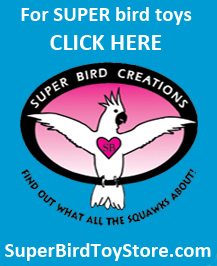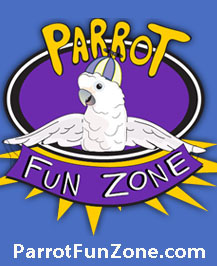An Introduction to Positive Reinforcement Training and its Benefits
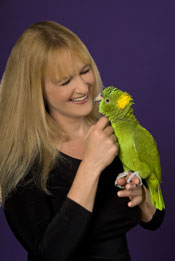 Macaws on bicycles, cockatoos raising flags, conures snatching dollar notes from audience members. These are images that often come to mind when the word “training” is mentioned in conjunction with parrots. While it is true that training is responsible for those resulting entertaining tricks, this short list of behaviors is a gross understatement of the endless potential training with positive reinforcement affords avian species in our care.
Macaws on bicycles, cockatoos raising flags, conures snatching dollar notes from audience members. These are images that often come to mind when the word “training” is mentioned in conjunction with parrots. While it is true that training is responsible for those resulting entertaining tricks, this short list of behaviors is a gross understatement of the endless potential training with positive reinforcement affords avian species in our care.
Training is simply teaching. When we train an animal with positive reinforcement we give it information on what it can do to earn desired outcomes. What behaviors we choose to teach are limitless. In addition to training birds for entertainment, we can use this form of communication to address behavior problems, to manage birds on exhibit, to teach birds to cooperate in their own medical care and/or to allow us to facilitate captive breeding practices.
Training is Science Based
Although training birds in general is not a new concept to avian enthusiasts, understanding the science behind training is just recently gaining momentum. The science behind training is called applied behavior analysis. This science focuses on how organisms learn. And truly we are all students of this science on a daily basis whether we are conscious of our application of its principles or not. Current trends in animal training choose to focus on using elements of this science that focus on kind and gentle strategies to create desired behavior and reduce undesired behavior. This includes avoiding the use of aversive punishment and negative reinforcement. In its place, trainers learn the art and skill of applying positive reinforcement to gain cooperation. (See definition below)
Positive Reinforcement: The presentation of a stimulus following a behavior that serves to maintain or increase the frequency of the behavior. Another name for positive reinforcement is reward training. Positive reinforcers tend to be valued or pleasant stimuli. To get positive reinforcers, learners often enthusiastically exceed the minimum effort necessary to gain them. Recommended!
Negative Reinforcement: The removal of a stimulus following a behavior that serves to maintain or increase the frequency of the behavior. Another name for negative reinforcement is escape/avoidance training. Negative reinforcers tend to be aversive or unpleasant stimuli. To avoid negative reinforcers, learners often only work to the level necessary to avoid them. Not recommended!
Punishment: The presentation of an aversive stimulus, or removal of a positive reinforcer, that serves to decrease or suppress the frequency of the behavior. The use of punishment tends to produce detrimental side effects such as counter aggression, escape behavior, apathy and fear. Also, punishment doesn’t teach the learner what to do to earn positive reinforcement. Not Recommended!
One of the benefits of viewing behavior and learning from a scientific approach is that we can avoid the pitfalls of relying on anecdotal information and/or anthropomorphic interpretations of behavior. In addition as a recognized science, the information belongs to everyone. No single individual has ownership of the methods or principles. They are available for each and everyone one of us to learn and apply. By understanding the science we are able to remove misconceptions and erroneous interpretations of behavior. The science also teaches us that even innate behaviors are modifiable. And most importantly we learn to create and modify behavior with kinder and gentler methods. This allows reduction in stress, trust building bonds with caretakers, the avoidance of learned aggressive behaviors and the many other drawbacks often associated when aversive strategies are used to influence behavior.
The Potential of Positive Reinforcement Training
In many ways the parrot community is still in its infancy as it identifies the potential formalized training programs have to vastly improve avian care and management practices. Positive reinforcement training has long been a part of the management and care of species such as captive whales and dolphins. Dog training has made tremendous changes in the last ten years towards focusing on positive reinforcement training. While this highly effective and far kinder method of influencing animal behavior is ready and waiting to be exploited to its fullest in the avian community, a movement of positive reinforcement training devotees has been working hard to spread the word to parrot enthusiasts around the world.
What these supporters have learned is that positive reinforcement training dispels many common misconceptions that currently exist about parrots. No longer do they believe that getting bit by their parrot is inevitable, no longer do they worry if their bird is perched higher than chest level, no longer do they assume their parrot will misbehave with strangers, and so on. They have learned that by applying positive reinforcement training strategies, they can teach their bird to eagerly present almost any behavior they can imagine. Positive reinforcement trainers commonly teach their birds to voluntarily present the following practical and useful behaviors.
- Step up onto the hand
- Step up onto the hand of other people
- Enter a kennel or other travel container
- Play in a towel
- Step onto a scale
- Go back into the cage
- Stay on desired play stands or cages
- Interact without aggressive behavior with other birds
Positive reinforcement trainers often also train behaviors that may seem focused on entertainment. However they also serve a very real function of building trust and enriching their birds lives. These include the following:
- Touching a target
- Wave with a foot
- Wave with a wing
- Stretch wings out
- Nod “yes”
- Shake head “no”
- Turn around
- Retrieve an object
- Talk on cue
Many of these seemingly impractical behaviors are also easily shaped into medical behaviors such allowing nail trims or clipping feathers without restraint. Some zoological facilities have trained parrots to allow the following medical behaviors without restraint (Video of which can be seen at Parrot Behavior and Training Workshops presented by the author)
- All over tactile exam
- Cloacal sampling
- Choanal sampling
- Ultrasound
- Radiograph
- Cloacal temperature reading
- Nebulization
- Masking for anesthesia
- Blood draws
In addition to providing the tools to train novel behaviors, understanding the principles of applied behavior analysis gives parrot enthusiasts the foundation needed to address behavior problems. Behavior problems such as biting, screaming, bonding to one person, fear of leaving the cage and feather destructive behavior are many times the result of a parrot learning what to do to create an environment that works for the bird. Unfortunately humans often inadvertently reinforce or create the undesired behavioral response the parrot is presenting. By understanding the function of the behavior and identifying the antecedents and consequences that serve to maintain the behavior, owners can proceed to develop strategies based on applied behavior analysis principles to address problem behavior.
Learning How to Train
Surprising to most, training with positive reinforcement is relatively simple. As with any skill it can be practiced. The more it is practiced, typically the better one becomes at its application. Many behaviors can be trained in one or two twenty minute training sessions. The following are a few terms that are helpful to know prior to delving further into the nuances of training with positive reinforcement.
Cue: A signal that tells the animal what to do. Many trainers use verbal and/or hand cues.
Bridge or bridging stimulus: A signal or marker that indicates when an animal has done something correct. It bridges the gap in time between when the animal did something correct and when it will receive positive reinforcement. Some examples of bridges are clickers, whistles, the word “good” or a touch.
Shaping a behavior with approximations: Once a desired behavior is identified, it is possible to look at that behavior as a series of small steps. The first step must be learned before moving on to the next step. Eventually all the steps when joined together lead up to the final desired behavior. Approximations are used quite often to train behaviors. This strategy can be used to train a bird to step up onto the hand, go onto a scale, step onto strangers, enter a kennel, wave and much more.
Training with approximations is like a dance between the trainer and the bird. The bird may take a few steps or approximations forward, but if the bird is hesitant to move forward more, the trainers may choose to accept a step that had been mastered previously. The training may remain at this step for a few repetitions as the bird gains confidence before a more challenging step is attempted again. There is a constant shifting and adjusting to meet the capabilities of the bird, but eventually more steps are taken forward then backward and the bird learns what the trainer is trying to teach. It is an intricate dance and one that makes training such an interesting activity. It challenges a trainer’s skills. Very rarely does training become boring. Each species, each individual, each behavior brings a new set of criteria to the table.
Using the terms described above and positive reinforcement as a training strategy we can explore the process of training a behavior. The first step is to identify a behavior to train. When training by shaping with approximations, it is helpful to describe in writing what each step might be. This can help a trainer visualize the process. In addition it is important to identify a cue for the behavior, a bridge and the type of positive reinforcement preferred by the training subject.
At first the bird will not understand the cue. Therefore the first step is to try to create the situation in which the bird will perform a small part of the behavior. For example to teach a bird to step up on the hand for positive reinforcement, sunflower seeds may be used to lure the bird towards the hand. If the bird takes a step towards the hand, the bird is “bridged” (the bridge signal is given) and offered a seed. While the bird is making the step towards the hand, a cue can be offered, such as the verbal cue “step up”. This associates the cue with the action of moving towards the hand. Over time the bird will make the connection that the verbal cue “step up” means to go to the hand. Eventually the goal is to phase out showing the sunflower seeds to encourage the performance of the behavior and only offer the cue.
When training a new behavior the sequence is as follows:
- Presentation of cue by the trainer
- Bird performs behavior or approximation towards desired behavior
- Bridge is given by the trainer for correct performance of behavior or approximation
- Positive reinforcement is offered by the trainer
- This process repeats itself as each approximation is added, until the final goal behavior is achieved.
Once a bird has gone through the approximations and clearly understands that the cue means to perform a particular behavior, the use of the bridge can be phased out for that behavior. The bridge is a good tool to help clearly communicate what is desired. However, once the behavior is learned it is not necessary. If the bird has problems with the behavior or is learning a new behavior, the bridge can always be reintroduced.
Although the bridge can eventually be removed, it is not recommended to phase out the positive reinforcement. Over time the bird will lose its motivation to perform the behavior. Reinforcement increases the likelihood the bird will perform a behavior; aversive or no consequences can decrease that likelihood.
Training a Retrieve
Learning new behaviors is mentally and physically stimulating for companion parrots. It is no secret that parrots are some of the most intelligent animals on earth. Having the opportunity to exercise their brain power is highly enriching. The following example describes the approximations one can take to teach a simple retrieve. It is also a great exercise for new trainers to use to practice applying the principles of training.
- Set the bird on a small perch (approximately one foot long). This will limit where the bird might choose to go.
- Offer from your hand a small toy, such as a plastic bead, or other small but heavy object. Usually birds will pick it up with their beaks out of curiosity. If the bird will not pick it up, try hiding a piece of food behind the bead so the bird must touch the bead with its beak. In this training scenario, the presentation of the bead may act as a visual cue, but you can also use a verbal cue such as “pick it up”. (Later this will be useful if you want the bird to retrieve other objects.)Bridge and reinforce when the bird touches the bead with its beak. Continue shaping touching the bead until the bird picks it up.
- Hold a small bowl under the bird’s beak. Eventually the bird will tire of the bead and drop it. Catch the bead in the bowl. Give the bridging stimulus you have chosen when the bead hits the bowl bottom. This can be clicking a clicker one time, or saying the word “good”. Decide the type of bridging stimulus you will use before you begin the session. After the bridging stimulus is given, offer the bird positive reinforcement. The positive reinforcement can be a sunflower seed or other food treat. Other forms of positive reinforcement can be offered such a head scratches or attention. Just be sure the bird finds these things positively reinforcing.
- Repeat this process several times.
- After several repetitions, move the bowl over to the side slightly. The bird will probably not drop the bead in the bowl. If this happens, do not bridge or reinforce. Offer the bead again. Allow the bird to miss and not get reinforced one or two times.
- Then go back to trying to catch the bead in the bowl. Bridge and reinforce.
- Try moving the bowl to the side again. If the bird gets the bead in the bowl offer a large reinforcement. If he misses, go back to step 3 and work up to step 5 again. Keep repeating this process until the bird understands the bead must go into the bowl in order to get the reinforcement.
- Once the bird gets the concept of the bead going into the bowl, start moving the bowl a little farther away. You will find you may have to go through steps 3-7 again. But eventually, you will be able to hold the bead on one end of the perch and the bowl on the other.
- Once this concept is understood by the bird, you can try switching the object to something else. When you do this, go back to holding the bowl under the bird’s beak and catching the object. Gradually approximate the bowl farther away. This should go quickly this time. Once the concept is well understood, try placing the bird and bowl on another surface such as a table. Again, you may need to repeat steps 3-7 to get on track. But eventually the bird will learn to generalize and perform the behavior in different environments and with different objects.
Conclusion
The good news about training is that it is not that hard to do. Understanding a few simple concepts can get parrot enthusiasts started on a path of discovery. Not only can training with positive reinforcement provide entertaining diversions, but it can also create well behaved parrots, reduce stress, avoid aggressive responses, and create an eager and enthusiastic participant. Most importantly it fosters the human animal bond that draws us to these fascinating creatures.
Freidman, S.G. (2005). “He Said, She Said, Science Says.” Good Bird Magazine. Volume 1 issue 1.
Friedman, S.G. (2005) “Straight Talk about Parrot Behavior” Good Bird Magazine Volume 1 Issue 3.
Friedman, S.G. and Heidenreich, B. (2005) “Pick a Principle” Good Bird Magazine. Volume 1 Issue 4.
Heidenreich, B. (2004) “Clicking with your Bird!” www.ParrotChronicles.com. Nov-Dec. Issue 19.
Heidenreich, B.E. (2004). Training Birds for Medical and Husbandry Behaviors. Proceedings Association of Avian Veterinarians annual conference.
**************************
Barbara has been a professional in the field of animal training since 1990. She owns and operates a company, Good Bird, Inc., (www.GoodBirdInc.com) that provides behavior and training products to the companion parrot community. These products include books, videos, and training/behavior workshops. She is the author of “Good Bird! A Guide to Solving Behavior Problems in Companion Parrots” by Avian Publications and also “The Parrot Problem Solver. Finding Solutions to Aggressive Behavior” by TFH Publications. She is the past president of the International Association of Avian Trainers and Educators (www.IAATE.org).
Barbara’s experience also includes consulting on animal training in zoos and other animal related facilities. Her specialty is free flight bird training. She has been a part of the development and production of more than 15 different free flight education programs. Barbara continues to provide consulting services to zoos, nature centers and other animal facilities through her other company Animal Training and Consulting Services (www.ATandCS.com). In her career she has trained animals, trained staff, and/or presented shows at facilities around the world.
Copyright 2006 Good Bird Inc. First Appeared in Bird Keeper Magazine. www.BirdKeeper.com.au. Cannot be reprinted without permission.
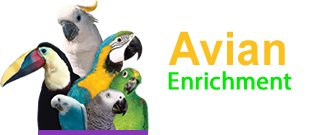

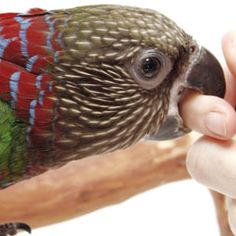 An all too common complaint from bird owners is that their bird bites. Indeed, most of us have been unexpectedly bitten by our birds at one time or another, seemingly for no reason at all. Bites can range anywhere from playful nips to severe bites causing blood loss, scarring, nerve damage and disfigurement. Being on the unpleasant end of the beak is not fun and it can hurt both physically and emotionally, if we let it.
An all too common complaint from bird owners is that their bird bites. Indeed, most of us have been unexpectedly bitten by our birds at one time or another, seemingly for no reason at all. Bites can range anywhere from playful nips to severe bites causing blood loss, scarring, nerve damage and disfigurement. Being on the unpleasant end of the beak is not fun and it can hurt both physically and emotionally, if we let it.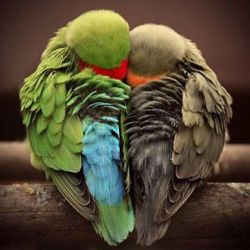 Scientists have long accused pet owners of anthropomorphism which is the act of attributing the human characteristics of thought, feeling and consciousness to pets. Even though supporting the notion of animals having emotions is the equivalent of committing heresy in the scientific world, there is an increasing acceptance that animals do have and feel emotions.
Scientists have long accused pet owners of anthropomorphism which is the act of attributing the human characteristics of thought, feeling and consciousness to pets. Even though supporting the notion of animals having emotions is the equivalent of committing heresy in the scientific world, there is an increasing acceptance that animals do have and feel emotions. 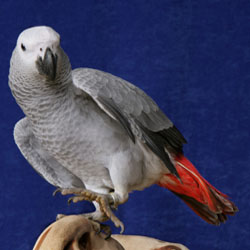 Parrots thrive on attention from their human flock and it is vital to their emotional well-being. Being locked up and abandoned in a cage to spend hours alone does not make for a very rewarding life. How much attention is too much? What type of attention is best?
Parrots thrive on attention from their human flock and it is vital to their emotional well-being. Being locked up and abandoned in a cage to spend hours alone does not make for a very rewarding life. How much attention is too much? What type of attention is best?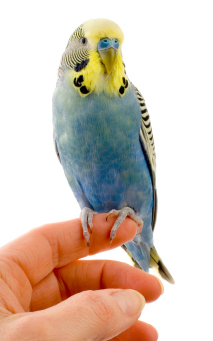 Just as human children do, parrots need to receive constant guidance as to what constitutes good behavior. Consistent limits and boundaries must be defined. This can be successfully achieved through the application of nurturing guidance principles and the use of positive reinforcement training techniques.
Just as human children do, parrots need to receive constant guidance as to what constitutes good behavior. Consistent limits and boundaries must be defined. This can be successfully achieved through the application of nurturing guidance principles and the use of positive reinforcement training techniques. Parrots are flock animals with an innate need for companionship and social interaction. A parrot derives it's greatest sense of physical and emotional security from living within a flock. Parrots are rarely alone in the wild. The social nature of a flock is very important to a bird's emotional well-being. Flocks participate in many activities together such as eating, traveling, preening, bathing, climbing, playing, roosting, vocalizing and socializing.
Parrots are flock animals with an innate need for companionship and social interaction. A parrot derives it's greatest sense of physical and emotional security from living within a flock. Parrots are rarely alone in the wild. The social nature of a flock is very important to a bird's emotional well-being. Flocks participate in many activities together such as eating, traveling, preening, bathing, climbing, playing, roosting, vocalizing and socializing.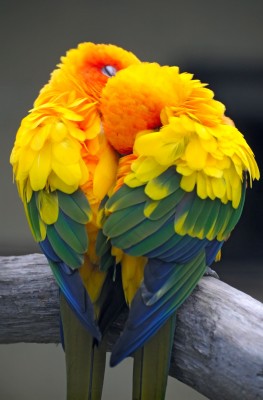 Once upon a time, in a land not so far away there lived a woman with seven dwarf parrots. All was peaceful and good until an evil magic came to the land blowing in on the warm air currents of spring. The woman's normally loving and happy dwarf parrots transformed right in front of her eyes into the seven evil hormonal dwarfs, who then came to be known as Screamy, Itchy, Plucky, Chewy, Clingy, Horny and Psycho......
Once upon a time, in a land not so far away there lived a woman with seven dwarf parrots. All was peaceful and good until an evil magic came to the land blowing in on the warm air currents of spring. The woman's normally loving and happy dwarf parrots transformed right in front of her eyes into the seven evil hormonal dwarfs, who then came to be known as Screamy, Itchy, Plucky, Chewy, Clingy, Horny and Psycho......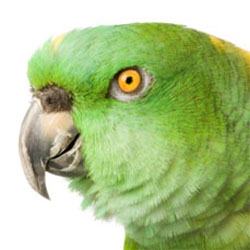 Learning your bird's language is key to having a productive, respectful relationship with your parrot. Birds can communicate in a variety of ways. If we are lucky, they use our own language to let us know what they want but certainly, they always convey their moods using their own unique vocalizations and body language.
Learning your bird's language is key to having a productive, respectful relationship with your parrot. Birds can communicate in a variety of ways. If we are lucky, they use our own language to let us know what they want but certainly, they always convey their moods using their own unique vocalizations and body language. Vocalizations are essential to a bird's existence in the wild. As social flock animals, they need to communicate with the other flock members about a host of topics - where the best eats are, where to meet up after a long days work to roost, to warn or scare away predators, to attract a mate or to warn off someone encroaching on their nest. In nature, the most vocal periods for bird are at sunrise and again at sunset.
Vocalizations are essential to a bird's existence in the wild. As social flock animals, they need to communicate with the other flock members about a host of topics - where the best eats are, where to meet up after a long days work to roost, to warn or scare away predators, to attract a mate or to warn off someone encroaching on their nest. In nature, the most vocal periods for bird are at sunrise and again at sunset.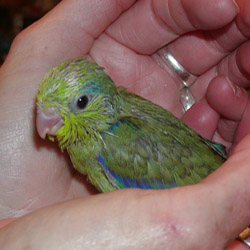 Simply put, socialization is the mechanism through which we teach our birds to function successfully within a human flock. In the wild, baby parrots remain with their parents for up to 2 years after they are weaned and fledged. This is a much longer developmental period than exhibited by other species of birds. During this extended training period they learn how to survive in their environment (what to eat, where to find it, how to eat it, how to remain safe from predators) and how to communicate with and participate as a member within their flock.
Simply put, socialization is the mechanism through which we teach our birds to function successfully within a human flock. In the wild, baby parrots remain with their parents for up to 2 years after they are weaned and fledged. This is a much longer developmental period than exhibited by other species of birds. During this extended training period they learn how to survive in their environment (what to eat, where to find it, how to eat it, how to remain safe from predators) and how to communicate with and participate as a member within their flock.